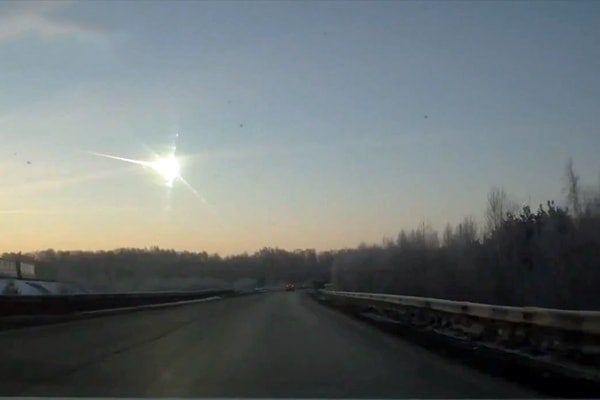
Exploding meteors, asteroids and Near Earth Objects
Published: February 15, 2013
Around the world on Feb. 15, people turned their gaze upon amateur video of a meteor that streaked across a Russian sky and exploded with ear-splitting force.
News agencies reported sonic blasts that shattered windows, injuring hundreds of people. Nature magazine said the explosion released as much energy as a nuclear blast and the Russian Academy of Sciences said the meteor weighed 10 tons and entered the earth’s atmosphere at a speed of at least 54,000 km/h and shattered between 30 to 50 kilometres above ground.
Reporters also noted the event occurred less than a day before experts anticipate the Earth will experience the closest pass ever of an asteroid: the asteroid 2012 DA14 is expected to pass within 28,000 km of the planet.
 U of T News asked Assistant Professor Michael Reid of the Department of Astronomy and Astrophysics for his perspective on the day's news.
U of T News asked Assistant Professor Michael Reid of the Department of Astronomy and Astrophysics for his perspective on the day's news.
Tell us about these events. Why are they capturing so much attention?
There are two big events today: the explosion of a meteor over Russia and the near flyby of asteroid DA14. The events seem to be unrelated, but of course they both point to the potential threats to Earth from asteroid impacts. It's very rare for a meteor to cause significant damage in a populated area, which is why the Russian event is attracting so much attention.
What can we learn from this?
What the public can learn from these events is the need to think carefully about the long-term hazards presented by asteroids. Although there are ongoing efforts to identify and characterize all potentially threatening NEOS (near Earth objects) obviously these efforts do not yet catch small objects, such as the one that exploded unexpectedly over Russia today. Not only do we need to do a lot more work finding all of these objects long before they pose a threat, we need to figure out how to destroy or, more likely, divert them. There is much to be done.
How does this relate to your research or teaching?
This doesn't tie in with my own research, which is mainly about star formation. It does tie in with the curriculum of AST 101, "The Sun and Its Neighbours". We do a section in that course on meteors and asteroids, discussing the threat they pose to Earth. In fact, I like to start that course off with a brief history of all of the times that life on Earth has been devastated by what seem to have been asteroid impacts. Extinction-level events are rare, but when they occur, everything changes. Mammals—and in particular human beings—dominate Earth today in part because the way was cleared for us by the asteroid impact that wiped out the dinosaurs.
Hopefully there won't be ant-people or slime-mold-people ruling the Earth in a few million years, talking about how the way was cleared for them when humans failed to avert their own annihilation. We talk about that kind of thing in AST 101.
What drew you to this field?
I was drawn to astronomy because of its potential to deal with these kinds of big issues. Who could not find the potential extinction of the human race fascinating? Of course, there are many other great mysteries in astronomy: How do stars and planets form? Is life rare or common in the cosmos? How did the universe come to exist? What are the natures of dark matter and dark energy, which seem to make up 96 per cent of the contents of the universe? There are so many amazing questions left to be answered.



